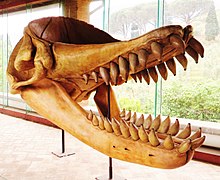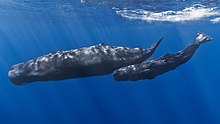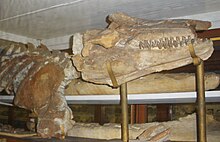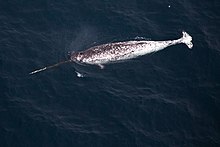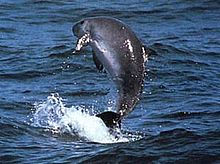Portal:Cetaceans
The Cetaceans Portal

Cetacea (/sɪˈteɪʃə/; from Latin cetus 'whale', from Ancient Greek κῆτος (kêtos) 'huge fish, sea monster') is an infraorder of aquatic mammals belonging to the order Artiodactyla that includes whales, dolphins and porpoises. Key characteristics are their fully aquatic lifestyle, streamlined body shape, often large size and exclusively carnivorous diet. They propel themselves through the water with powerful up-and-down movement of their tail which ends in a paddle-like fluke, using their flipper-shaped forelimbs to maneuver.
While the majority of cetaceans live in marine environments, a small number reside solely in brackish water or fresh water. Having a cosmopolitan distribution, they can be found in some rivers and all of Earth's oceans, and many species inhabit vast ranges where they migrate with the changing of the seasons.
Cetaceans are famous for their high intelligence, complex social behaviour, and the enormous size of some of the group's members. For example, the blue whale reaches a maximum confirmed length of 29.9 meters (98 feet) and a weight of 173 tonnes (190 short tons), making it the largest animal ever known to have existed.
There are approximately 89 living species split into two parvorders: Odontoceti or toothed whales (containing porpoises, dolphins, other predatory whales like the beluga and the sperm whale, and the poorly understood beaked whales) and the filter feeding Mysticeti or baleen whales (which includes species like the blue whale, the humpback whale and the bowhead whale). Despite their highly modified bodies and carnivorous lifestyle, genetic and fossil evidence places cetaceans as nested within even-toed ungulates, most closely related to hippopotamus within the clade Whippomorpha. (Full article...)
Selected picture

The Humpback Whale (Megaptera novaeangliae) is a mammal which belongs to the baleen whale suborder. It is a large whale: an adult usually ranges between 12–16 m (40–50 ft) long and weighs approximately 36,000 kilograms (79,000 lb). It is well known for its breaching (leaping out of the water), its unusually long front fins, and its complex whale song. The Humpback Whale lives in oceans and seas around the world, and is regularly sought out by whale-watchers.
More did you know...
- ...the male narwhal's tusk can be up to 3.5 metres in length which is over the size of an average female without a horn and weigh up to 10 kilograms.
- ...male narwhal(e)s tusk is the canine growing through the lip. Sometimes, the male will have 2 tusks but their number is small. Female narwhal(e) rarely have a tusk and if they do, it must be smaller than the males. Also,there is only 1 recorded case of a dual horned female narwhal(e)
- ...observations of cetaceans date back to at least the classical period in Greece, when fisherpeople made notches on the dorsal fins of dolphins entangled in nets in order to tell them apart years later.
- ...groups of bottlenose dolphins around the Australian Pacific have displayed basic tool use by wrapping pieces of sponge around their beaks to prevent abrasions. This is a display of a cognitive process similar to that of great apes.
- ...Herman Melville's novel Moby-Dick had real-life inspiration, a notorious male sperm whale named Mocha Dick.
- ...the Voyager Golden Record carried into space whale songs, among other sounds.
Things you can do..
|
|
Here are some Cetaceans WikiProject tasks you can do.
|
General images -
Did you know (auto-generated)

- ... that the South Asian river dolphin is nearly blind and relies on echolocation for navigation?
- ... that one can swim with humpback whales in the Niue Nukutuluea Multiple-Use Marine Park?
- ... that one of the first researchers to propose dolphin-assisted therapy for humans later renounced it?
- ... that Celia Kaye won the Golden Globe Award for Most Promising Newcomer in 1965 for her starring role in Island of the Blue Dolphins?
Selected media
List articles
Related portals
WikiProjects

The content you are reading was created by Wikipedia volunteers. See WikiProject Cetaceans for more.
- See also: Wikispecies, a Wikimedia project dedicated to the classification of species.
Cetacean articles
Categories
For additional lists of marine life-related featured articles and good articles see:
Associated Wikimedia
The following Wikimedia Foundation sister projects provide more on this subject:
-
Commons
Free media repository -
Wikibooks
Free textbooks and manuals -
Wikidata
Free knowledge base -
Wikinews
Free-content news -
Wikiquote
Collection of quotations -
Wikisource
Free-content library -
Wikispecies
Directory of species -
Wikiversity
Free learning tools -
Wikivoyage
Free travel guide -
Wiktionary
Dictionary and thesaurus





